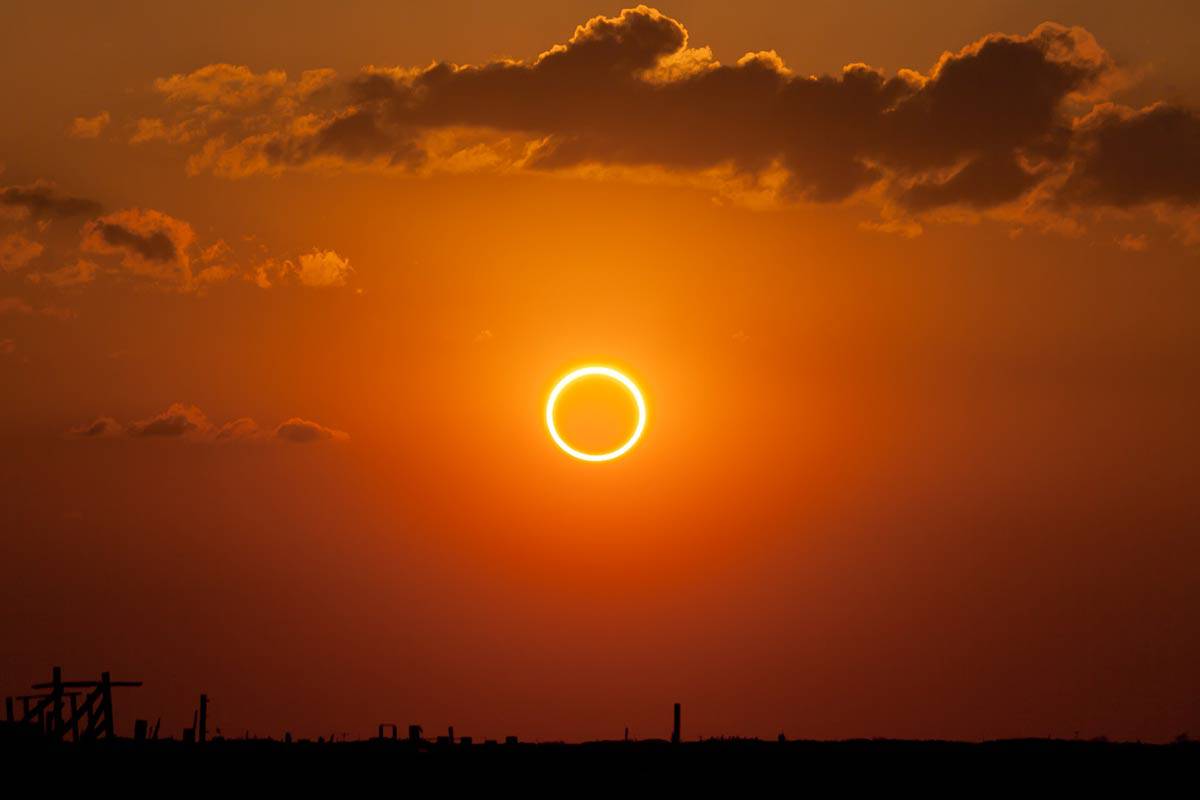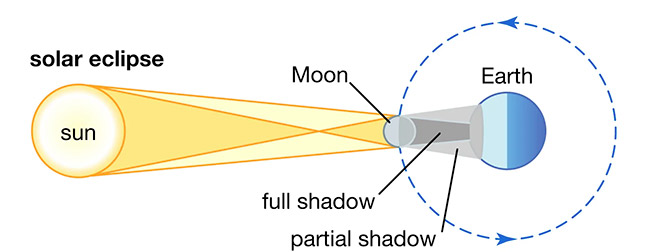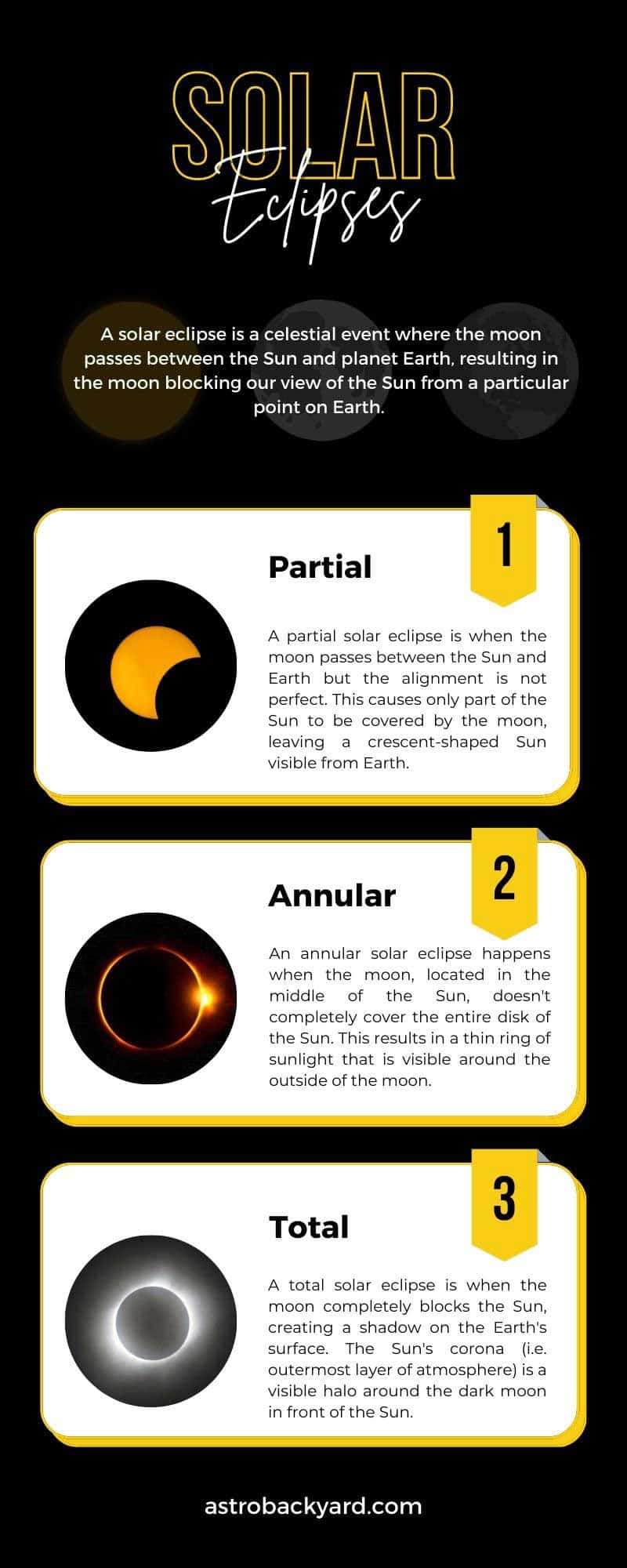Types of Solar Eclipses
What is a Solar Eclipse?
A solar eclipse is a celestial event where the moon passes between the Sun and planet Earth, resulting in the moon blocking our view of the Sun (either totally or partially) from a particular point on Earth.
As an astrophotographer who has spent the majority of his time under the night sky, witnessing the moon slowly pass in front of the sun during the day is not something that happens very often. In fact, I am still waiting to see my first total solar eclipse in 2024.
But what exactly causes a solar eclipse, and how can we observe this rare phenomenon safely? In this article, I’ll break down the different types of solar eclipses, the safety precautions that must be taken to observe them, and the history of humanity’s fascination with these celestial events.
There are three different types of solar eclipses:
- Partial: A portion of the Sun is covered
- Annular: A ‘ring of fire’ shines around the moon, centered in front of the sun
- Total: The Sun is fully covered by the moon
A ‘Ring of Fire’ Annular Solar Eclipse. Photo by Kevin Baird (Flickr).
The type of eclipse depends on the alignment of the moon, Earth, and the Sun, and how far away the moon is from Earth.
There is also an eclipse known as a hybrid, which is a combination of a total and annular eclipse where the moon’s shadow moves across Earth.
IMPORTANT: It is not safe to look directly at the Sun without eye protection made for solar viewing. Never view the Sun through a camera lens, binoculars, or telescope without a proper solar filter over the front of the optics to avoid serious eye injury.
A Total Solar Eclipse appears beneath the cloud cover. Stephen C F Burt (Flickr).
Partial Solar Eclipse
A partial solar eclipse is when the moon passes between the Sun and Earth but the alignment is not perfect. This causes only part of the Sun to be covered by the moon, leaving a crescent-shaped Sun that is visible from Earth.
Because there is such a narrow path/area to observe a total solar eclipse, those outside the path would view a partial solar eclipse.
The amount of Sun covered would depend on how far away the observer’s location was from the path. They would then see a total solar eclipse at 90% or 80%, which would then be considered a partial solar eclipse.
You would not notice a difference in brightness from a partial solar eclipse. It takes over 90% coverage to notice the sky getting darker.
Partial Solar Eclipse over Lake Ontario. Trevor Jones.
Annular Solar Eclipse
An annular solar eclipse happens when the moon, located in the middle of the Sun, doesn’t completely cover the entire disk of the Sun. This results in a thin ring of sunlight that is visible around the outside of the moon.
This type of eclipse is only visible from a very narrow path on the Earth’s surface, with the duration dependent on the location of the observer.
During this type of eclipse, the moon is furthest away from Earth in its orbit, which is why it looks as though the moon is actually smaller than the Sun. Given this dynamic between the moon and Sun, the alignment of these objects must be just right in order to create an annular eclipse.
Annular Solar Eclipse | NASA
Total Solar Eclipse
A total solar eclipse is when the moon completely blocks the Sun, creating a shadow on the Earth’s surface. The Sun’s corona (i.e. its outermost layer of atmosphere) is a visible halo around the dark moon in front of the Sun.
The sky becomes dark in the path of totality, which is usually only a few dozen miles wide. This path will stretch across the Earth’s surface in a narrow band. Outside of the path, observers will see a partial solar eclipse where a greater portion of the Sun visible the further away they are from totality.
These types of eclipses are more rare because they require a precise alignment between the moon and the Sun. They can also only occur during a new moon phase and when the moon is closest to Earth in its orbit.
A total solar eclipse generates a lot of excitement among amateur astronomers, eclipse chasers, and observers. It provides a unique view of the Sun and its surrounding environment as well as interesting photographic opportunities.
Total Solar Eclipse | NASA
There are a few different effects to look for during a total solar eclipse that happen just before or just after the moon completely covers the Sun:
- Baily’s beads effect: as the moon covers the Sun during a total solar eclipse, you can see the rugged topography of the moon that allows only sparse amounts of sunlight to shine through in certain areas. Look for these irregularities on the edge of the moon just before totality and immediately afterward.
- Diamond ring effect: happens right before or after the moon covers the Sun during a total solar eclipse. With only a small portion of sunlight remaining, it creates the appearance of a shining ‘single diamond’ on the edge of a ring.
- Prominences: with only a small portion of sunlight showing during a total solar eclipse, there is the chance to see gaseous formations on the surface of the Sun. They start on the surface and extend out into the Sun’s outer atmosphere (i.e. corona).
Stages of Total Solar Eclipses
There are five stages to a total solar eclipse:
- First contact: the moon starts to move in front of the Sun, crossing the first edge and creating a partial solar eclipse.
- Second contact: the moon reaches the opposite edge of the Sun, which is the beginning of the total solar eclipse.
- Totality: the moon completely covers the Sun and the corona of the Sun will be visible. This stage will only last a few minutes.
- Third contact: the moon starts to move away from the Sun, ending the total solar eclipse. The bright light of the Sun becomes visible in the opposite the direction the moon is moving in. The partial eclipses continues.
- Fourth contact: the partial eclipse ends as the moon moves out of the Sun disk.
Frequency of Solar Eclipses
The frequency of solar eclipses varies due to the changing distances and angles between the Sun, Moon, and Earth over time.
The alignment of the moon, Sun and Earth takes place approximately every six months during a period of time known as eclipse season. This results in two to five solar eclipses each year, though they are not visible from every location on Earth.
If the orbit of the moon was perfectly circular and in the same orbital plane as Earth, there would be a total solar eclipse each month during every new moon phase. However, this doesn’t happen due to the 5 degree tilt of the moon’s orbit, causing its shadow to miss Earth.
Partial solar eclipses happen more frequently than total solar eclipses, and can be seen from more locations on Earth. A total solar eclipse will occur somewhere on Earth every 18 months or so.
This may seem frequent, but the path of totality (the location on Earth where the Sun is completely covered) is only a few hundred kilometers wide. This means that during a total solar eclipse, only a small portion of the Earth surface (i.e. locations) are able to see the total eclipse.
Size Difference between the Sun and Moon
During a total solar eclipse, it looks as though the moon and the Sun are the same size, since the moon can block the entire Sun.
The reality is that the diameter of the Sun is approximately 400x larger than the moon. But the Sun also happens to be 400x further away from Earth than the moon. It’s this ‘match’ of size difference and distance that makes the Sun and the moon appear to be the same size, and is also the reason we are able to observe a solar eclipse.
This also impacts the moon shadows (i.e. the umbra, penumbra and antumbra) and how they play out during a solar eclipse. A moon’s shadow has two parts:
- Penumbra: the outer, lighter (partial) shadow where the Sun is only partially blocked by the moon.
- Umbra: the inner, darker (full) shadow where the Sun is completely blocked by the moon.
During a total solar eclipse, the region on Earth where people observe the moon completely covering the Sun is within the umbra. This is known as the path of totality. Those outside this path will observe a partial solar eclipse in the penumbra.
Difference Between Solar and Lunar Eclipses
All eclipses involve the moon, Sun, and Earth. The main difference between a solar eclipse and a lunar eclipse is the order of these objects.
As mentioned, a solar eclipse happens when the moon passes between the Sun and the Earth. This results in the moon blocking the Sun causing a decrease in daylight and a shadow being cast on Earth. This type of eclipse can only happen during the new moon phase.
Solar Eclipse Diagram | Brittanica
A lunar eclipses, however, happens when the Earth passes between the Sun and the Moon. This results in the Earth’s shadow falling on the moon, creating a reddish/brown change in colour as the atmosphere from Earth filters the sunlight. This type of eclipse can only happen during the full moon phase.
Lunar Eclipse Diagram | Brittanica
Below is a quick summary of the differences between a solar and lunar eclipse.
| Solar Eclipse | Lunar Eclipse | |
|---|---|---|
| Order of celestial bodies | Sun, Moon, Earth | Sun, Earth, Moon |
| Moon Phase | During New Moon Phase | During Full Moon Phase |
| Frequency | Occurs once in 18 months | Occurs twice a year |
| Timing | Occurs during the day | Occurs at night |
| Shadow/Umbra | Moon's shadow on Earth | Earth's shadow on Moon |
| Appearance | Disk of light around the moon or crescent shaped | Reddish Moon |
| Hazards | Do not obsesrve or photograph without specialized equipment and filters | No special filters or equipment needed. Can look at with your naked eye. |
How to Enjoy Solar Eclipses
There are many ways to safely enjoy a solar eclipse. Again – never look directly at the Sun without proper equipment as it can cause permanent eye damage.
- Indirectly View it: You can safely observe a solar eclipse without looking directly at it. A homemade pinhole projector is an example of something you can make at home to view an eclipse. Never look directly at the solar eclipse with the homemade projector.
- Using Eclipse Glasses: Eclipse glasses are made with solar filters designed to look at the Sun. Be sure to inspect your eclipse glasses before using them. Do not use these glasses to look through a camera, binoculars, or telescope. They require specialized filters designed for that use.
- Using Camera/Telescope Solar Filters: Solar filters are separate filters that must be attached to the front of any telescope, binoculars, camera lens, etc. Consult an expert astronomer before using a solar filter with a camera, telescope, binoculars etc.
- Observe Environmental Changes: With the moon blocking the Sun, it will not only get darker but also cooler. If enough light is blocked, it can look like dusk in the middle of the day. This can cause changes in wildlife behavior (i.e. birds fall quiet, the presence of bats, etc.), which can be interesting to observe.
Ashley using solar eclipse glasses to safely look at the sun.
Photographing a Solar Eclipse
IMPORTANT: Never view the Sun through a camera lens or telescope without a proper solar filter over the front of the optics to avoid serious eye injury.
There are a few ways to safely photograph a solar eclipse using the appropriate filters, but one of the most popular options is to use a white light solar wedge. This will allow you to capture the Sun up close, using the focal length of your refractor telescope.
This type of solar filter acts the same way a diagonal does and inserts into the focus of your existing refractor telescope. The Lunt White Light Wedge (shown below) allows you to safely view and photograph eclipses, sun spots, and more.
Solar wedges like the one shown below are only safe to use with a refractor telescope. The heat of the sun will become too concentrated inside an SCT, Reflector, or Maksutov telescope design.
For an even better photo, many amateur astrophotographers choose to take pictures of the sun using a hydrogen-alpha dedicated solar telescope like the Coronado 40mm F/10 PST shown below.
A specialized hydrogen alpha (H-alpha) solar telescope can safely reveal solar prominences, flares, filaments, and other interesting solar events. A solar telescope like this isolates the far end of the Sun’s visible light spectrum (656 nm).

The H-alpha Solar Disk captured by Sergio Castillo. Agena Astro Products.
In 2021, I captured an image of a Partial Solar Eclipse from southern Ontario, Canada. The following takes you through the excitement of that moment.
When is the Next Total Solar Eclipse?
The next total solar eclipse is coming up on April 8, 2024. The path of totality will pass over Mexico, the United States, and Canada.
Cities located in the path of totality will experience an uptake in tourism as people travel to these areas at a glimpse at this event. We plan to travel to Doaktown, New Brunswick for a view of the eclipse in the path of totality under darker, (and hopefully) clear skies.
2023/2024 Total and Annular Solar Eclipse Path | Celestron
For a detailed list of locations that will be in the path of totality, visit 2024 Solar Eclipse.
For an update on future solar eclipse events, check out timeanddate.com











